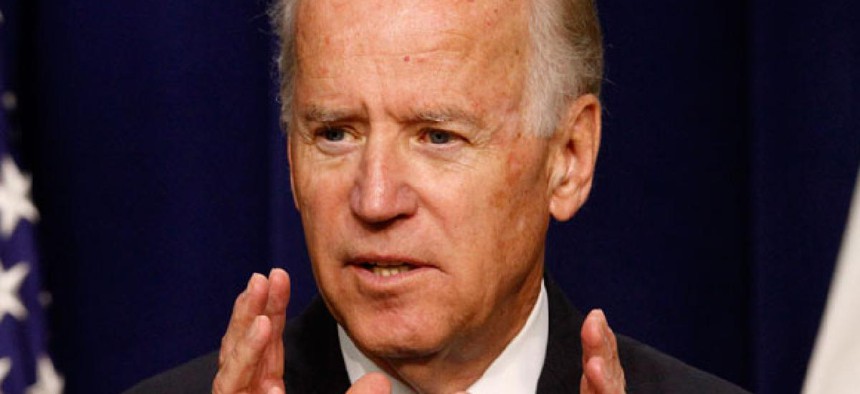
Jacquelyn Martin/AP
Paying Contractors No More Than Biden Makes Could Save $440M a Year
New GAO numbers on contractor salary reimbursement rekindle debate.
A fresh estimate of how much the Defense Department shells out to reimburse major contractors for their executive salaries has revived an ongoing debate and prompted reintroduction of legislation to cap the compensation at the level of the vice president’s salary.
The Government Accountability Office on Wednesday released results of a study of 27 major contractors showing that capping the reimbursement rate for reimbursable contractor salaries at the level of the president ($400,000) — a rate proposed recently by the Office of Management and Budget — would save the government $180 million per year, and setting the cap at the vice president’s salary ($230,700) would save at least $440 million per year.
The current cap, set in law in the late 1990s, is $763,029 for 2011 and 2012. The Obama administration, federal employee unions and various lawmakers in recent years have sought to reduce the reimbursement rate, though major contractors argue such a step would harm their competitive edge in attracting talent.
GAO found that among the 27 contractors reviewed, fewer than 200 employees in any one year had compensation costs over the existing cap, but this number would have increased to more than 500 if the cap had been set at the president's salary and to more than 3,000 if set at the vice president’s.
The report made no recommendations and cautioned that the sample is not generalizable. The Pentagon, in commenting on a draft, questioned whether the sampling -- just 7 percent of its contracting -- is widely applicable.
In response on Wednesday, Sens. Barbara Boxer, D-Calif.; Chuck Grassley, R-Iowa; and Joe Manchin, D-W.Va., joined with Rep. Paul Tonko, D-N.Y., to introduce the 2013 Commonsense Contractor Compensation Act, described as bipartisan, bicameral legislation to cap the maximum taxpayers reimburse all government contractors for their salaries at the same amount as the vice president earns. It would also extend the cap to cover all defense and civilian contractor employees, rather than just defense contractors and the top five executives of nondefense contractors.
“This stunning GAO report shows that thousands of government contractors are raking in taxpayer-funded salaries that are significantly more than what the vice president of the United States and members of the president’s Cabinet make,” said Boxer in a joint press statement.
“The direct taxpayer-funded salaries of contractors governmentwide clearly need to be contained, and this legislation is designed to do so in a comprehensive way,” Grassley said.
“When taxpayer-funded federal contractors take home up to four times the amount our military leadership earns, it is a problem that needs to be addressed,” Tonko said.
A dissenting note came from Stan Soloway, president and CEO of the Professional Services Council, a contractors trade group. “The GAO report has some interesting data insofar as it relates to a relatively miniscule sample of the government contracting sector, but as a tool for policymaking it is sorely lacking in both context and depth," he said.
"The sample size of 27 companies is simply too limited and the analysis does not take into account how the proposed caps match up against the demands of the broader marketplace for talent, which is where companies, like the government, must be able to compete," he continued. "In the end, that is the most important and relevant question. Unfortunately it remains unanswered.”
He added that the study “conflates the terms ‘salary’ and ‘compensation,’" noting that the president receives much more in benefits than in salary.
OMB commented on the report to note that growth in the cap has outpaced inflation and the rate of growth of federal salaries.







